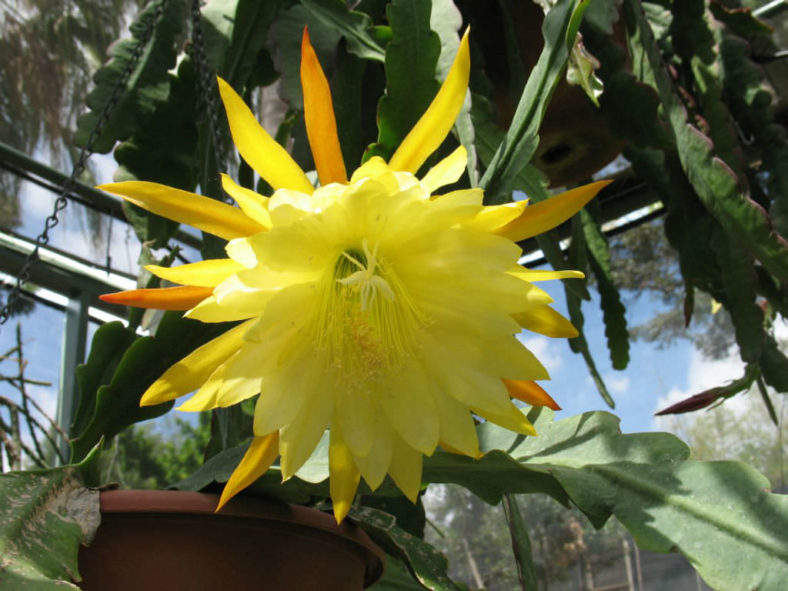Epiphyllum is a genus of cacti often grown as houseplants as they are relatively trouble-free. They are commonly known as Orchid Cacti. These cacti produce large, showy, usually sweetly-scented flowers that last two days or more. Some species, such as Epiphyllum oxypetalum, are nocturnal, with their flowers opening at night. Epiphyllums are mostly epiphytic, which means they grow on other plants but only use them as support. They are often grown in hanging baskets to accommodate their long, pendent, leaf-like stems but can also be grown in containers.
Growing Conditions
Epiphyllums are hardy down to 30 °F (-1.1 °C) but require at least 60 °F (15 °C) during the growing season, so they are best grown in a heated greenhouse or indoors.
Place the pots in bright filtered light with moderate to high humidity. To increase the humidity, position the pot on a tray filled with gravel and keep this topped up with water, but not enough so that the water reaches the surface.
Epiphyllums require sharply drained growing media. Grow them in a standard cactus soil mix with added grit or perlite. Alternatively, mix three parts loam-based compost, with two parts grit or perlite and one part peat-free multipurpose compost.

Pruning and Training
Overlong stems can be cut off or shortened. New shoots will usually develop just behind the cut. However, be careful not to overwater after pruning, as the plant's water requirements will be reduced.
Large Epiphyllums can become unstable in their pots. Either repot into a heavier pot, such as terracotta, or a wider container, such as a pan. Alternatively, try using canes and tying the stems up, but this can look unsightly.
Propagation
The two most successful propagation methods of Epiphyllum are by using seeds and cuttings.
Sowing seed:
- Sow seed in spring or summer.
- Fill a container with cactus soil mix and scatter the seed evenly on the surface.
- Moisten the compost lightly with a fine mist sprayer.
- Top dress with a thin layer of fine grit.
- Cover the pot with a clear plastic bag, place it into a propagator, and keep it at 70°F (21°C).
- Remove the covering once the seeds have germinated.
- Keep the compost moist but not wet.
- Prick out when the seedlings become crowded and large enough to handle comfortably.
- They will take four to seven years to flower.
Cuttings: Take stem cuttings from spring to late summer.
- Cut the leaf-like stem into 6 to 9 inches (15 to 22.5 cm) sections and let it callus for several days in a warm place.
- Fill a pot one-third full with cactus soil mix and cover it with a layer of grit. Insert the cuttings 1 to 2 inches (2.5 to 5 cm) deep.
- Keep the compost moist and maintain temperatures of 65 to 75 °F (18 to 24 °C).
- They should root in three to six weeks and flower the following year if taken early in the season.
Pests and Problems
Epiphyllums are prone to several common houseplant and greenhouse problems: mealybugs, aphids, and glasshouse red spider mites.
Grower's Tips
From spring to fall, water the plants when the soil begins to dry, but do not let the plants stand in water. Apply cactus fertilizer fortnightly. To encourage blooming, move Epiphyllums in winter into a cooler place, about 52 to 57 °F (11 to 14 °C), and keep the compost moist until the flower buds form. Once this has happened, increase the temperature and resume the regular watering regime.
Source: rhs.org.uk
Links
- Back to genus Epiphyllum
- Succupedia: Browse succulents by Scientific Name, Common Name, Genus, Family, USDA Hardiness Zone, Origin, or cacti by Genus